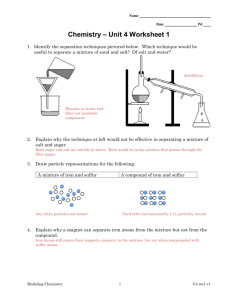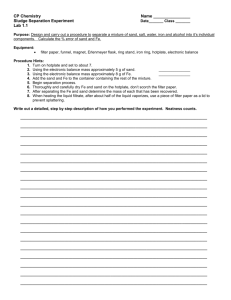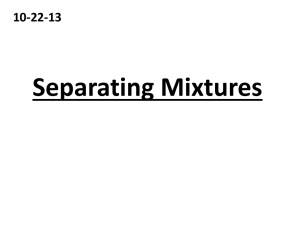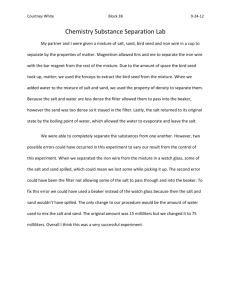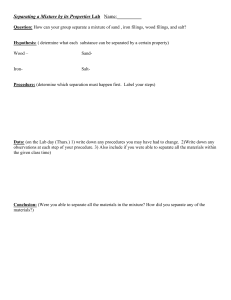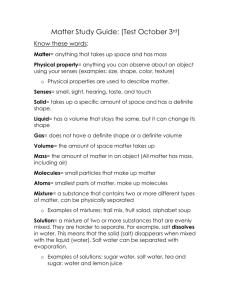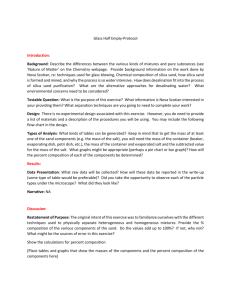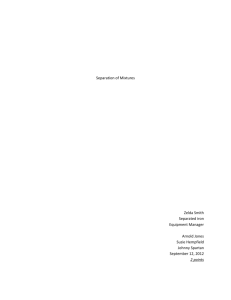Sand, Salt and Iron Inquiry Lab
advertisement
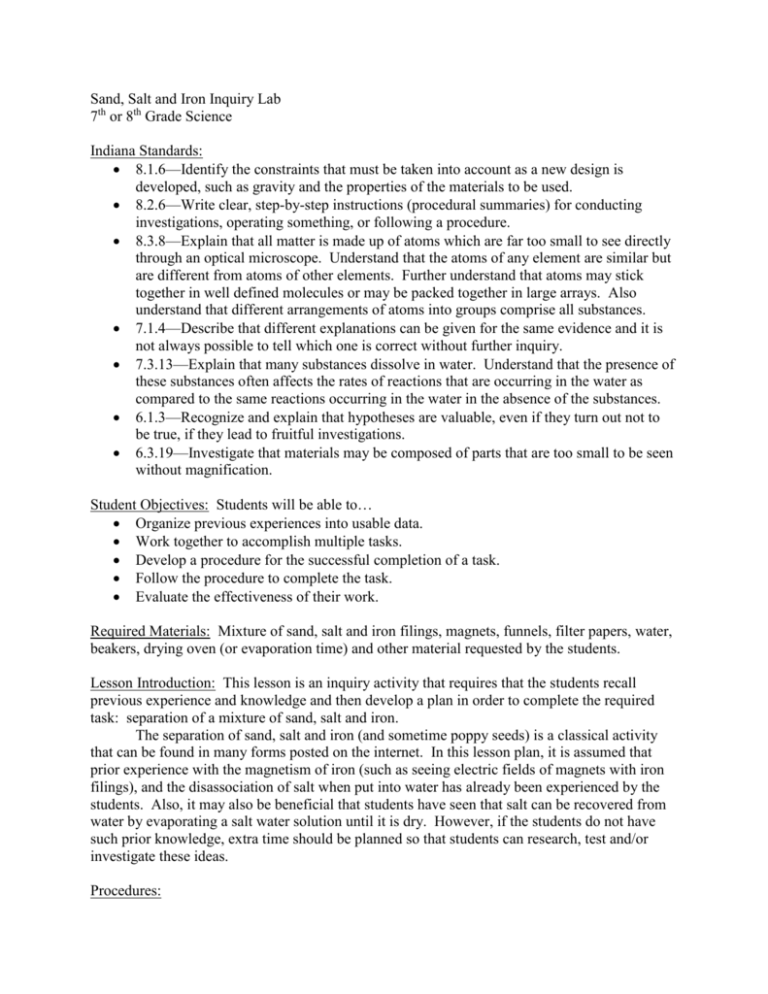
Sand, Salt and Iron Inquiry Lab 7th or 8th Grade Science Indiana Standards: 8.1.6—Identify the constraints that must be taken into account as a new design is developed, such as gravity and the properties of the materials to be used. 8.2.6—Write clear, step-by-step instructions (procedural summaries) for conducting investigations, operating something, or following a procedure. 8.3.8—Explain that all matter is made up of atoms which are far too small to see directly through an optical microscope. Understand that the atoms of any element are similar but are different from atoms of other elements. Further understand that atoms may stick together in well defined molecules or may be packed together in large arrays. Also understand that different arrangements of atoms into groups comprise all substances. 7.1.4—Describe that different explanations can be given for the same evidence and it is not always possible to tell which one is correct without further inquiry. 7.3.13—Explain that many substances dissolve in water. Understand that the presence of these substances often affects the rates of reactions that are occurring in the water as compared to the same reactions occurring in the water in the absence of the substances. 6.1.3—Recognize and explain that hypotheses are valuable, even if they turn out not to be true, if they lead to fruitful investigations. 6.3.19—Investigate that materials may be composed of parts that are too small to be seen without magnification. Student Objectives: Students will be able to… Organize previous experiences into usable data. Work together to accomplish multiple tasks. Develop a procedure for the successful completion of a task. Follow the procedure to complete the task. Evaluate the effectiveness of their work. Required Materials: Mixture of sand, salt and iron filings, magnets, funnels, filter papers, water, beakers, drying oven (or evaporation time) and other material requested by the students. Lesson Introduction: This lesson is an inquiry activity that requires that the students recall previous experience and knowledge and then develop a plan in order to complete the required task: separation of a mixture of sand, salt and iron. The separation of sand, salt and iron (and sometime poppy seeds) is a classical activity that can be found in many forms posted on the internet. In this lesson plan, it is assumed that prior experience with the magnetism of iron (such as seeing electric fields of magnets with iron filings), and the disassociation of salt when put into water has already been experienced by the students. Also, it may also be beneficial that students have seen that salt can be recovered from water by evaporating a salt water solution until it is dry. However, if the students do not have such prior knowledge, extra time should be planned so that students can research, test and/or investigate these ideas. Procedures: 1. Split the students into appropriate lab groups. 2. Provide each group with a beaker that contains a mixture of sand, salt and iron. Also, give each group the challenge to separate the mixture into separate beakers, one each of sand, salt and iron. 3. Provide the groups with the following instructions: a. Each group must record in their lab books what they and their fellow lab partners know about each material that is in the beakers. b. Each group must make a step-by-step plan on how they are going to be successful and the plan must be approved by their teacher before they begin the laboratory. c. Groups may only use supplies in the lab when they have approval from their teacher and when they have appropriate safety gear in place. d. Groups may seek additional information from books, magazines and the internet to help them put together their plan. e. Once a group has attempted their plan, they must decide if it was successful and explain why or why not. 4. Explain instructions. 5. Have groups begin to work in their lab books. Circulate and observe. 6. Supervise activities and work. Depending on prior knowledge, this may take several class periods. 7. Provide extra exercises for those groups that finish earlier than others. Closure: When all groups have finished have students write in their science journals/lab books based on these questions. 1. Is separating a mixture of sand, salt and iron easy? Explain your answer. 2. Was your group successful in separating the sand, salt and iron? Why or why not. 3. Do you think all mixtures can be separated like you did the sand, salt and iron? 4. What did you learn about sand, salt and iron? 5. What would you do if poppy seeds (have examples for the students to examine) were in the mixture all? How might you separate them out as well? Assessment: The teacher will… Observe the students during the lab activity. Review each group’s proposals for appropriateness. Read each student’s writing in their science journals.

